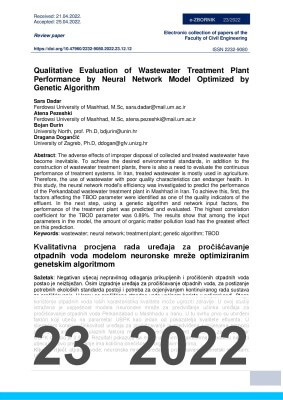ISSN 2232-9080
QUALITATIVE EVALUATION OF WASTEWATER TREATMENT PLANT PERFORMANCE BY NEURAL NETWORK MODEL OPTIMIZED BY GENETIC ALGORITHM
- Issue: No. 23, June 2022, Vol. 12
- Author(s): Sara Dadar, Atena Pezeshki, Bojan Đurin, Dragana Dogančić
- Type: Review paper
- DOI: https://doi.org/10.47960/2232-9080.2022.23.12.12
Abstract: The adverse effects of improper disposal of collected and treated wastewater have become inevitable. To achieve the desired environmental standards, in addition to the construction of wastewater treatment plants, there is also a need to evaluate the continuous performance of treatment systems. In Iran, treated wastewater is mostly used in agriculture. Therefore, the use of wastewater with poor quality characteristics can endanger health. In this study, the neural network model's efficiency was investigated to predict the performance of the Perkandabad wastewater treatment plant in Mashhad in Iran. To achieve this, first, the factors affecting the TBOD parameter were identified as one of the quality indicators of the effluent. In the next step, using a genetic algorithm and network input factors, the performance of the treatment plant was predicted and evaluated. The highest correlation coefficient for the TBOD parameter was 0.89%. The results show that among the input parameters in the model, the amount of organic matter pollution load has the greatest effect on this prediction.
Keywords: wastewater; neural network; treatment plant; genetic algorithm; TBOD







